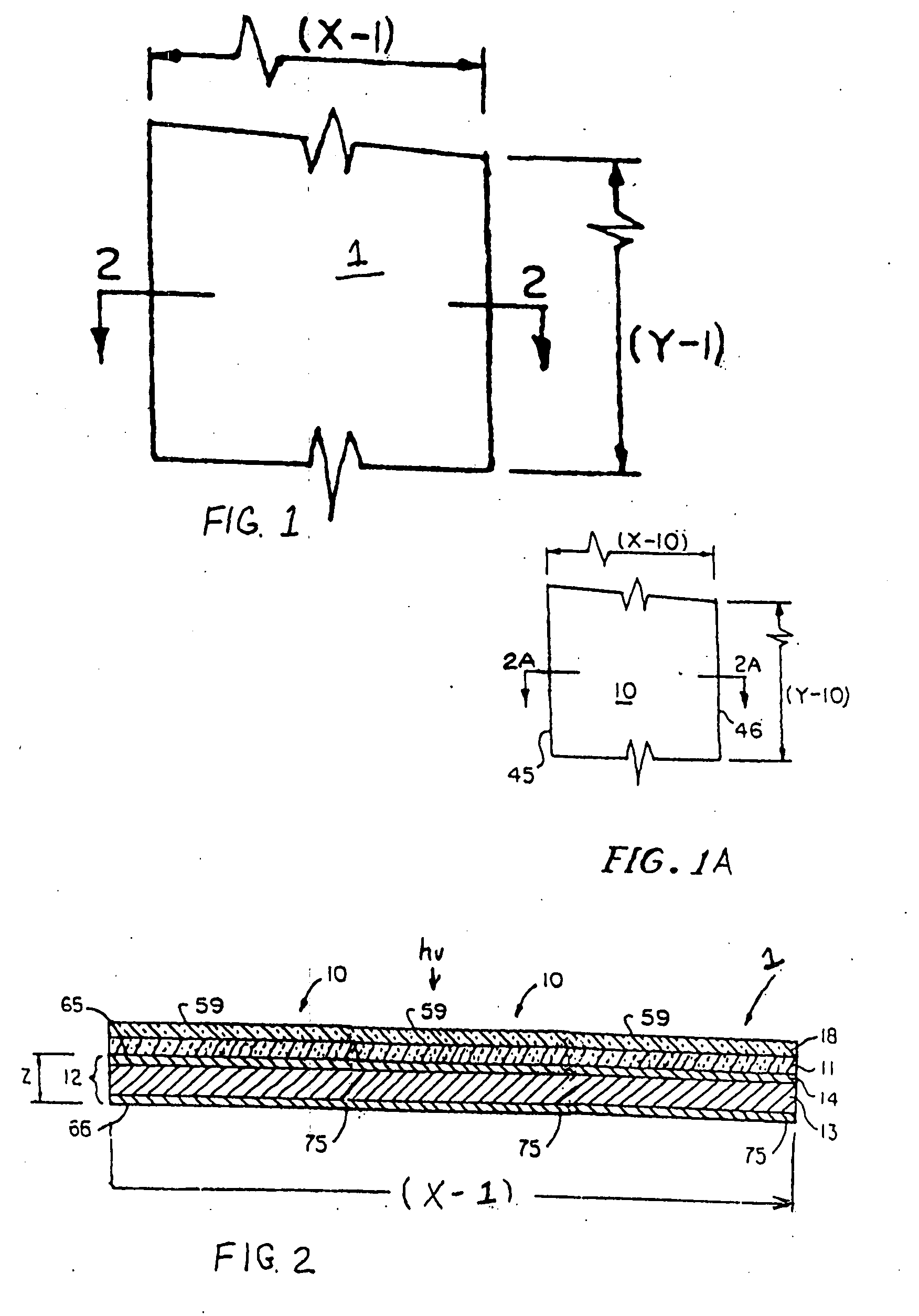Collector grid, electrode structures and interconnect structures for photovoltaic arrays and other optoelectric devices
- Summary
- Abstract
- Description
- Claims
- Application Information
AI Technical Summary
Benefits of technology
Problems solved by technology
Method used
Image
Examples
example 1
[0278] A standard plastic laminating sheet from GBC Corp. 75 micrometer (0.003 inch) thick was coated with DER in a pattern of repetitive fingers joined along one end with a busslike structure resulting in an article as embodied in FIGS. 46 through 47C. The fingers were 0.020 inch wide, 1.625 inch long and were repetitively separated by 0.150 inch. The buss-like structure which contacted the fingers extended in a direction perpendicular to the fingers as shown in FIG. 46. The buss-like structure had a width of 0.25 inch. Both the finger pattern and buss-like structure were printed simultaneously using the same DER ink and using silk screen printing. The DER printing pattern was applied to the laminating sheet surface formed by the sealing layer (i.e. that surface facing to the inside of the standard sealing pouch).
[0279] The finger / buss pattern thus produced on the lamination sheet was then electroplated with nickel in a standard Watts nickel bath at a current density of 50 amps. p...
example 2
[0283] An interconnecting substrate structure was produced in the following way. A non-woven fabric sheet comprising polypropylene fibrils, having intrinsic “through holes” of typical dimension approximately 0.002 inch and a thickness approximately 0.002 inches was selected. This starting sheet had a length of 12 inches and a width of 8.5 inches. A DER ink comprising solids of 66 percent Kraton rubber (Trademark Kraton Polymers), 30 percent Vulcan XC-72 conductive carbon black (product of Cabot Corp.), 2 percent sulfur and 2 percent MBTS was selected. The DER ink was coated in strips 1 inch wide separated by 1 inch (2 inch center to center distance) extending in the length direction. Coating was performed on both opposite sides to insure that the ink fully extended through the holes joining opposite surfaces of the fabric. The strips were then electroplated with approximately 5 micrometers nickel from a standard Watts nickel bath followed by approximately 5 micrometers copper from a...
example 3
[0289] An interconnected array of three cells according to the arrangement depicted in FIG. 64 was prepared. Initial preparation of the collector stock (such as depicted in FIG. 62) was accomplished in a fashion very similar to production of the collector stock as in Example 2. The major difference in production of the Example 3 collector stock was the inclusion of the through holes allowing electrical communication between opposite surfaces of the stock. Dimensions for the individual cells and individual collector grids were identical as those for the Example 2. The electrical joining among adjacent cells (identified by numeral 42 in FIG. 64) was accomplished using a thin film of the same conductive carbon loaded adhesive used for Example 2. Since there is no interconnect “dead area” associated with the FIG. 64 arrangement, the total area of the 3 cell array was 39.4 square inches (1.75″×7.5″×3). In full noon time sun, the Example 3 array had a short circuit current of 2.1 amperes ...
PUM
 Login to View More
Login to View More Abstract
Description
Claims
Application Information
 Login to View More
Login to View More - R&D
- Intellectual Property
- Life Sciences
- Materials
- Tech Scout
- Unparalleled Data Quality
- Higher Quality Content
- 60% Fewer Hallucinations
Browse by: Latest US Patents, China's latest patents, Technical Efficacy Thesaurus, Application Domain, Technology Topic, Popular Technical Reports.
© 2025 PatSnap. All rights reserved.Legal|Privacy policy|Modern Slavery Act Transparency Statement|Sitemap|About US| Contact US: help@patsnap.com



